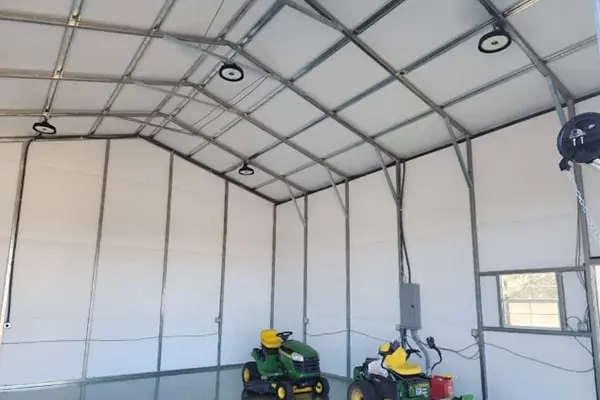Steel buildings are known for their durability, cost-effectiveness, and versatility, making them a popular choice for everything from warehouses to workshops and even residential homes. However, one common question that arises is whether a steel building can be insulated effectively. The answer is a resounding yes—an insulated steel building not only provides a comfortable environment year-round but also offers significant energy savings and protection against the elements. Here’s how insulation can be effectively applied to steel buildings and why it’s a worthwhile investment.
Why Insulate a Steel Building?
Before delving into how to insulate a steel building, it’s important to understand why insulation is beneficial. Steel buildings, by nature, conduct heat and cold very efficiently, which means they can become uncomfortably hot in the summer and freezing cold in the winter. Without proper insulation, the temperature inside a steel building can fluctuate dramatically, leading to an uncomfortable environment and higher energy costs due to increased heating and cooling needs.
An insulated steel building provides numerous benefits, including:
- Temperature Control: Insulation helps maintain a consistent indoor temperature, making the building more comfortable for occupants or for storing temperature-sensitive goods.
- Energy Efficiency: By reducing the need for heating and cooling, insulation can significantly lower energy bills, making the building more cost-effective to operate over time.
- Moisture Control: Insulation also acts as a barrier against moisture, preventing condensation, which can lead to rust, mold, and structural damage in steel buildings.
- Noise Reduction: Insulating a steel building can help reduce noise from outside, creating a quieter and more productive indoor environment.
Types of Insulation for Steel Buildings
Several types of insulation can be used to insulate a steel building, each with its own set of benefits. The choice of insulation depends on the building’s intended use, location, and budget.
1. Fiberglass Insulation
Fiberglass insulation is one of the most common and cost-effective options for an insulated steel building. It consists of fine glass fibers woven into batts or rolls, which are then placed between the steel framing members.
Benefits:
- Affordable: Fiberglass insulation is generally less expensive than other types of insulation, making it a popular choice for budget-conscious projects.
- Good Thermal Performance: It provides effective thermal insulation, helping to keep the building warm in winter and cool in summer.
- Easy Installation: Available in batts and rolls, fiberglass is relatively easy to install, especially in standard-sized steel buildings.
Considerations:
- Moisture Sensitivity: While fiberglass does not absorb moisture, it can lose its insulating properties if it becomes wet, so a proper vapor barrier is essential.
2. Spray Foam Insulation
Spray foam insulation is a versatile and highly effective option for insulating steel buildings. It is applied as a liquid that expands and hardens, creating an air-tight seal that provides excellent thermal insulation.
Benefits:
- High R-Value: Spray foam offers one of the highest R-values per inch, making it highly effective for insulating steel buildings.
- Air and Moisture Barrier: It creates a continuous barrier that prevents air leaks and resists moisture, which is crucial for steel buildings where condensation can be an issue.
- Longevity: Once applied, spray foam insulation is durable and long-lasting, requiring little maintenance over time.
Considerations:
- Higher Cost: Spray foam insulation is more expensive than other types of insulation, which can be a drawback for some projects.
- Professional Installation: It typically requires professional installation, adding to the overall cost.
3. Reflective or Radiant Barrier Insulation
Reflective insulation, also known as radiant barrier insulation, is particularly effective in hot climates. It consists of a reflective material, such as aluminum foil, that reflects radiant heat away from the building.
Benefits:
- Energy Efficiency: Reflective insulation reduces cooling costs by reflecting heat away from the building, making it ideal for steel buildings in hot climates.
- Moisture Control: It also helps prevent condensation and moisture buildup, which can protect the steel from rust and corrosion.
Considerations:
- Limited Thermal Insulation: Reflective insulation does not provide as much thermal resistance as other types, making it less effective in colder climates.
4. Rigid Foam Board Insulation
Rigid foam board insulation is made from materials like polystyrene or polyisocyanurate and is known for its high insulating value. These boards can be cut to fit any space and are often used in walls, roofs, and floors of steel buildings.
Benefits:
- High R-Value: Foam boards offer excellent thermal resistance, making them ideal for both hot and cold climates.
- Durability: They are resistant to moisture, mold, and pests, making them a long-lasting option for steel buildings.
Considerations:
- Installation Complexity: Installing foam boards can be more labor-intensive, especially when cutting and fitting around corners and obstacles.
Conclusion
In conclusion, not only can a steel building be insulated, but doing so is highly beneficial for energy efficiency, comfort, and structural integrity. By choosing the right type of insulation—whether it’s fiberglass, spray foam, reflective, or rigid foam board—you can ensure that your insulated steel building is well-protected against temperature extremes, moisture, and noise. Proper insulation will enhance the functionality of the building, making it a smart investment for any steel structure owner.
Post time: Aug-28-2024




